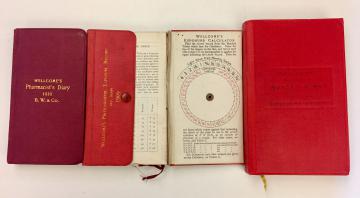Burroughs, Wellcome and Company was the pharmaceutical firm established in London in 1880 by two young American pharmacists, Silas Mainville Burroughs and Henry Wellcome. They brought not only new pharmaceutical preparations and production techniques, but also new methods of marketing and advertising to the UK. Part of that strategy was the provision of free drug samples and gifts in the form of blotters, specially written medical guides and books, and annual medical diaries. It was as early as 1882 that an Indian military surgeon suggested to Burroughs, then on a world-wide trip to establish overseas agencies and drum up business, that a small handbook of modern scientific medicine simply written and aimed primarily at doctors would be extremely useful. Seizing upon the suggestion, Wellcome, back in London, immediately got to work on producing such a volume, which included an index of medicines and diseases, articles that emphasised how the company’s products could be used to treat many such conditions and a complete list of all the medicines then sold by Burroughs, Wellcome & Co. Initially 25,000 books, some bound in leatherette, some in cloth, were freely distributed to doctors around the world especially within the British Empire. The enthusiastic reception of this first batch prompted the printing of a further 20,000, many of which were distributed to non-medical recipients: to American and English consulates, overseas chemists, leading clergy and missionaries, and plantations throughout the colonies. The campaign, Wellcome reported to his globe-trotting partner, ‘took the profession by storm’.
This success encouraged the company to start producing many different publications, which they continued to do for many decades. These appeared in a variety of languages and all contained details of Burroughs, Wellcome products. They included small handbooks on specific diseases or therapies; travel guides to coincide with medical conferences; informational booklets on museums and exhibitions; and an expanding series of diaries. Initially produced just for doctors, as the annual ‘medical diary’, soon specialised volumes for nurses, pharmacists, and photographers (the company produced a large and profitable range of chemicals and films for the amateur and professional photographer) were produced (see Fig 1). So useful were these diaries seen to be, especially by the medical profession, that they often achieved the rare distinction of being reviewed in the medical press. Examples of these diaries, produced specifically for different audiences across the world, are in the archives of the Wellcome Foundation in the Wellcome Library in London.
By 1890, the routine pages of the ABC Medical Diary included not only weekly pages for engagements and appointments, but also sections to record home visits, book obstetric cases, and, of extreme importance to a late nineteenth century medical practitioner, pages for financial accounts. Not only were the diaries, especially the medical versions, still distributed freely to a select list, but they were also sold, being advertised using the routine channels employed for other goods. One series of adverts, aimed particularly at pharmacists, suggested that they might ‘wish to buy Christmas presents for medical friends’ at a cost of between 2/6 and 5/- , depending on the quality of the binding (see Fig 2).

Initially appearing in early December, the advert was shrewdly re-used two weeks later on 27th December, when those who had missed the original opportunity were reminded of the opportunity to purchase ‘New Year presents for medical friends’ (see Fig 3)!
Further reading:
Church R A, Tansey E M. (2007) Burroughs, Wellcome & Co. Knowledge, Trust, Profit and the transformation of the British pharmaceutical industry, 1880–1940. Carnegie Publishing, Lancaster.
Tansey E M. (2008) Vendre medicaments arreu del món: L’empresa farmacéutica Burroughs Wellcome & Co. Mètode: (Science, publicity and propaganda) 59: 85–91.






